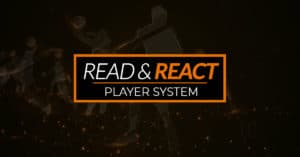As coaches, we are always looking for new plays to put our players in scoring situations and ultimately win more games. These plays usually come from 1 of 3 sources, DVD, clinics (notes), or live television. Every coach is able to teach their players plays, but not every coach teaches the play to be most effective. I wanted to take a few minutes today and speak on a topic that many coaches do not put enough emphasis on, the angles at which screens are set.
Regardless if you are running the Read & React offense of set plays, there are four main types of screens in basketball: Ballscreens, Downscreens (wide pin-downs), Cross-screens, and Backscreens. Before I dive into each type of screen, there is one common theme that must be followed, the player receiving the screen must be patient and wait for the screener. Failing to be patient will result in a poor screen and/or an offensive foul on the screener.
Ballscreen
Setting a ballscreen is only effective if the screener actually makes contact with the on-ball defender and forces the defense to help. Too many times players set ballscreens within their offense and continually fail to make contact on their screens, yet coaches continue to run the play. Setting the most effective ballscreens is a two part system, as I mentioned earlier the ball handler must be patient and wait for the screen and the player setting the screen must set it at an angle on the defense that stops them in their tracks or forces the defense over top.
When I teach my players how to set ballscreens, I tell them to try and set it on the area between the defender’s outer hip and outer rear, similar to a backscreen. Essentially the back of the screener should be pointing towards the angle of attack the ball handler wants to take with their first dribble(s). Setting it straight on (the hip) will allow the defender to easily slide under the screen with minimal contact. Setting it too far on their back (flat) will allow the defender to easily slide over top with minimal contact. Furthermore, try to set the screen as close as possible to the defender (without fouling) to give the defender the smallest amount of space to navigate around. This angle of screening is extremely hard to guard and will also get your ball handlers going more downhill towards the rim.
As you can seen below the angle should be slightly adjusted when the ball is on the side.
Downscreen (Wide Pin-Down)
Downscreens are probably the most popular screens in basketball. From an early age, players are taught two kinds of offense: pass and cut, pass and screen away. Like every screen though, it is ineffective if not set properly. The key to setting a great downscreen is creating an angle at which the defender cannot easily slide over or under. If the screeners’ shoulders are parallel to the baseline the defense can easily slide under and re-attach. Conversely, if the screeners’ shoulders are too open to the sideline the defense can fight over top making a lock & trail much easier. Lock & trail is attaching to the player ‘s lower hip (almost behind) and chasing them of the screens trying to stay attached.
Backscreen
The third type of screen is a backscreen. Backscreens are somewhat easier to set because the defender cannot see the screen coming (if their teammates fail to communicate). Backscreens should be set almost straight on the back of the defender. Notice I said almost. There needs to be a slight angle with the screen because as the player (4) starts using the screen the defense will start moving backwards at a slight angle as well. The screeners mid-line (center of body) should almost straddle to outer leg of the defender. Using the example below, if the X (of X4) is the defender’s right leg, 3’s legs should straddle the X.
Cross-screen
Cross-screening is one of easiest actions to teach, the players simply move across and set a screen on the side of the defense. While it is basic to teach, it has numerous options making it extremely difficult to guard. The cross-screen has four simple reads to teach your players to counter how the defense guards the cross-screen. You can practice these reads by drilling them non-stop until it becomes second nature to your players. Since my time at the University of Florida, I have yet to see a combo of bigs perfect these reads like Al Horford, Joakim Noah, Chris Richard, and Adrian Moss did. Those four guys knew exactly what each other was going and scored quite a bit off the four actions below.
I hope that you found this topic interesting and informational. If you ever have any questions or suggestions about anything we post please do not hesitate to contact us.











